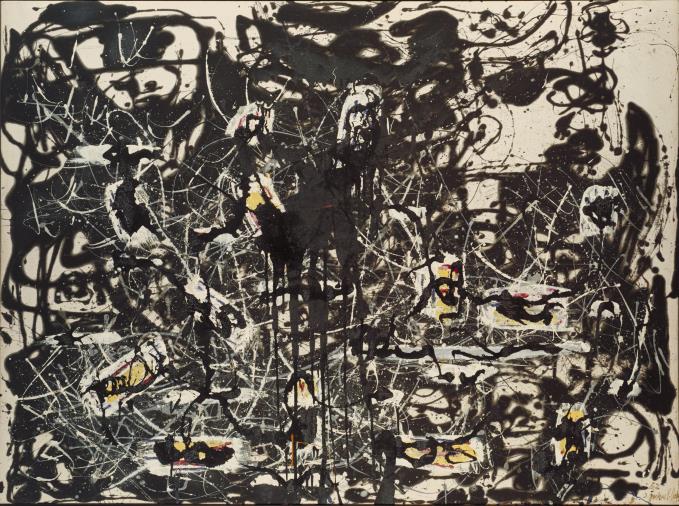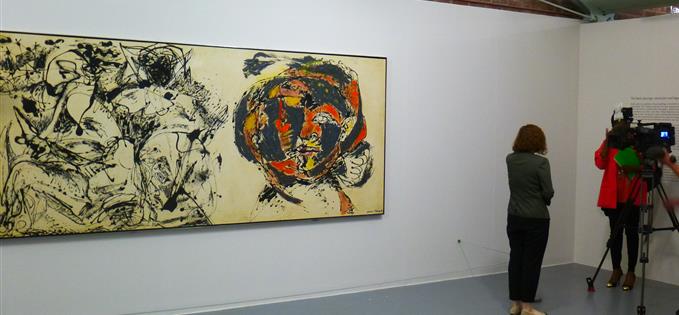NEARLY 60 years after his death in a car crash, and a whole lifetime away from the day he was labelled America's Greatest Artist, Jackson Pollock can still get people going.
"My 10-year-old can do better than that," they snort. And they go out to prove it, creating their own Jackson Pollocks in the hope that paint sloshed around with gay abandon will fool the know-all critics and artistic pseuds.
Fat chance. They've been turning up in America at the rate of one a month since the late 1950s, and not one has fooled the real experts at the Pollock-Krasner Authentication Board, which keeps an eye on these things.
"Someone even lifted what they reckoned was Pollock's DNA off the floor of his studio," observes Gavin Delahunty, curator of Jackson Pollock - Blind Spots, the big summer exhibition at Tate Liverpool this year.
"They put it on to the canvas, but it was the eyes of the staff that spotted it was wrong. A real Pollock just jumps out at you when you know his work."
And there are few who know Jackson Pollock's work better than Delahunty. As he shows the artistic press corps round the exhibition, his enthusiasm is boundless and his energy inexhaustible.
There's no room for doubt where he is concerned. A work of genius leaps out from every wall, and even those not versed in the ways of abstract expressionism can see very quickly that there is a huge talent at work.
Jackson Pollock was born in 1912 in Wyoming and brought up in Arizona and California. He trained as an artist on the east coast of the USA and began to make a name for himself in the late 1930s.
He avoided the use of brushes and an easel, preferring to drip and splash paint straight onto a canvas, flat on the floor. Not for nothing did Time Magazine once dub him Jack the Dripper.
The Liverpool show concentrates on a number of darker, relatively late Pollock works from the early 1950s, known as the Black Pourings. There are enough of his earlier work to put the later stuff into perspective, but the Black Pourings - a series of black enamel and oil paintings - are what it's all about.
In fact there are over 20 of them, making the Tate's exhibition the biggest showing of the Black Pourings ever held on either side of the Atlantic.
 Jacskon Pollock died in a drink driving accident aged 44
Jacskon Pollock died in a drink driving accident aged 44They stem from a time when Pollock was looking to take a new direction, striving to develop and push himself, in Delahunty's words. In 1965 art historian Michael Fried remarked that Pollock’s Black Pourings saw him ‘on the verge of an entirely new and different kind of painting … of virtually limitless potential’.
Pollock was free, for a while, from the dependence on alcohol that had run through so much of his life. But it was not to last, and after one final and fascinating masterpiece in 1953 - Portrait And A Dream (pictured top and at the end here) - his work was of lesser quality. He died in a car crash in 1956, one of the most high-profile of all drink-drive casualties.
Two other exhibitions run alongside Jackson Pollock, and Tate Director Francesco Manacorda is very keen to refer to them collectively as the Tate's Summer Season.
Glenn Ligon is one of America's leading contemporary artists as well as a writer and critic. But he takes something of a back seat at the Tate, curating a show entitled Encounters and Collisions.
Maybe 10 per cent of the show is his own work, with the rest being a personal survey of the many artists who have fascinated and influenced him. "Showing the range of possibilities," as he puts it.
 Yellow Island
Yellow IslandThere's everyone who's anyone there, from Cy Twombly though Jasper Johns, Chris Ofili, Adrian Piper, Willem de Kooning, Andy Warhol and more. In some ways it hardly deserves to be seen against the Jackson Pollocks - and indeed it was a free-standing show earlier this year in Nottingham - but taken together it makes for a well-rounded and fascinating show.
The third leg of the Summer Season is provided by Geta Bratescu in her first solo exhibition in the UK.
Now in her late 80s, she is still an active artist in her native Romania with a career stretching back to the 1940s right up to the modern day, wit some collages created especially for the Tate.
Jackson Pollock: Blinds Spots, Glenn Ligon, Encounters and Collage, and Geta Bratescu are at the Tate Gallery, Liverpool from June 30 to October 18. Admission Adult £11 (without donation £10) Concession £8.25 (without donation £7.50). Tate members get in free.
9/10
 Number 34, 1949
Number 34, 1949
















